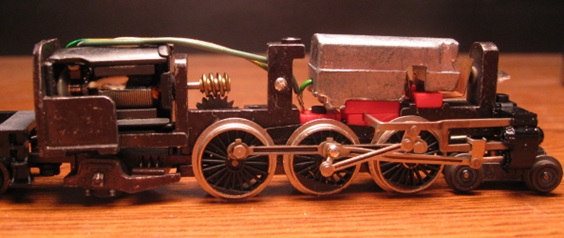Introduced: 1970 (discontinued circa 1999)
This model was actually designed by Ted Brandon, an American serviceman (and ardent model railroader) stationed in Germany in the late 1960s. Interestingly enough, Ted was also involved in designing Arnold's USRA 4-6-2 steamer (released in 1968). Circa 1979, Minitrix recycled the K4 shell and tender for use on a 2-10-0 model (a somewhat misguided experiment that is covered elsewhere on this site).
Although imported into the US by Model Power, I've never seen these locomotives in anything but cardboard "Minitrix" boxes. These models ultimately vanished from the face of the Earth around 1999 when Marklin bought out Minitrix and discontinued their line of USA-prototype models. They remain in high demand to this day (apparently being a reasonably accurate representation of a popular PRR prototype). However, sticklers should be aware that the proportions of the boiler are off as compared to the real thing (too small).

The motor is an open-sided 3-poler. All of the driver axles are geared, and except for the plastic idler gear, all of the gearing is metal. A non-directional headlight is mounted in the front of the chassis. Although the tender has a back-up light lens built into it, it is non-operational (IE, no bulb inside the tender). The tender comes with a Rapido-style coupler, whereas the pilot is equipped with a non-functioning knuckle coupler. The tender and engine shells are plastic. The engine chassis is metal (with a free-floating weight for additional heft).
These models don't have any problems with narrow-radius curves, the running gear action is very smooth, all of the various trucks seem to stay on the rails quite reliably, pulling power is decent, and overall they run fairly quietly. Unfortunately, the wheel flanges are quite huge, so forget about operating one on anything like Atlas Code-55 track.
The main problem with these models is poor slow speed performance (stalls and stuttering) due to poor pickup. Which is completely mind-boggling, given how many of this thing's wheels actually conduct current. First off, both tender trucks provide pickup (with two wheels on the forward truck picking up left-rail current, and two wheels on the rear truck picking up right-rail current). Said current is transferred to the motor via a stiff wire on the drawbar as well as a second free-floating insulated wire.

As for the engine, all six drivers conduct current (although two of the left-side drivers are equipped with traction tires, rendering them electically neutral). To compensate for the traction tires, the left wheel on the trailing truck and the two left wheels on the pilot truck also pick up left-rail current. So, with all that electricity flowing to the motor, you'd think there'd be no way this thing would ever stall out. Unfortunately, the tender trucks make use of fairly primitive (and unreliable) axle-wipers. The spring wire on the drawbar connection is notoriously unreliable. And finally, the pilot and trailing trucks on the engine are too light to reliably conduct current. So yeah, you can highball this thing around pretty well. But back off on the throttle even a little and chances are it'll come to a screeching halt.
A common modification to address the pickup issue is to replace the tender trucks (and their axle wipers) with Kato or Bachmann tender trucks. This will go a long way towards improving performance. Unfortunately, "as delivered" these models are pretty much useless.
The K4 remained essentially the same throughout its lifespan, however Minitrix did make a couple of minor modifications over the years. At some point, the tender wiring was changed such that both wires were of the flexible, insulated type (replacing the unreliable "spring wire" on the drawbar). Also, a couple of different plastic idler gears (the one turned by the worm) were used. Earlier runs have red plastic idler gears whereas later runs have black plastic gears (and with the latter having slightly greater gear reduction, and hence, slower overall speeds). Despite the gear changes, all of these models have a tendancy to start too fast (along with having ridiculously high top-end speeds).
To remove the locomotive shell, simply unscrew the screw on top (inside one of the domes). To remove the tender shell, pry the sides apart to free the two clips on the tender chassis.
Grade: C